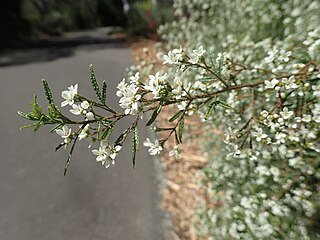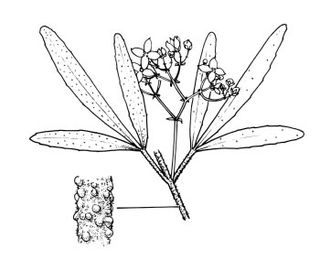
Zieria laevigata commonly known as smooth zieria, smooth-leaved zieria or twiggy midge bush is a species of flowering plant in the citrus family Rutaceae and is endemic to eastern Australia. It is an erect shrub with smooth, three-part leaves and pale pink or white flowers with four petals and four stamens. It grows in poor soil on rocky outcrops and flowers from late winter to spring.

Zieria adenophora, commonly known as the Araluen Zieria is a plant in the family Rutaceae and is only found near Araluen in the Southern Tablelands of New South Wales. It is a spreading shrub with small glossy, warty leaves and white or pink four-petalled flowers in spring. It is a rare plant with fewer than one hundred plants known from only one site.

Zieria collina commonly known as hill zieria, is a plant in the citrus family, Rutaceae and is endemic to a small area in south-east Queensland. It is a large, spreading shrub with leaves composed of three leaflets, and small flowers with four white petals.

Zieria adenodonta, commonly known as the Wollumbin zieria, is a plant in the citrus family Rutaceae and is endemic to eastern Australia. It is a dense, bushy shrub with leaves composed of three leaflets which are warty on the upper surface. In winter and early spring it has groups of five to eight flowers, each with four white petals, the groups usually shorter than the leaves.

Zieria tuberculata, commonly known as warty zieria, is a plant in the citrus family Rutaceae and is endemic to a small area on the south coast of New South Wales. It is a shrub with warty, hairy branches and leaves and large groups of creamy-white, four-petalled flowers in late winter to spring.

Zieria baeuerlenii, commonly known as the Bomaderry zieria, is a plant in the citrus family Rutaceae and is endemic to a small area on the south coast of New South Wales. It is a sometimes straggly shrub with velvety leaves composed of three leaflets. In late autumn to spring there are clusters of small white to pinkish flowers with four petals and which appear to be unable to produce seeds.

Zieria buxijugum, commonly known as the Box Range zieria, is a plant in the citrus family Rutaceae and is endemic to a small area on the south coast of New South Wales. It is a dense, rounded shrub with strongly scented, velvety, clover-like leaves composed of three leaflets. In early spring there are large clusters of small white flowers with four petals near the ends of the branches.

Zieria caducibracteata is a plant in the citrus family Rutaceae and is endemic to New South Wales. It is a tall shrub or small tree with leaves composed of three lance-shaped leaflets. In early spring there are clusters of small white flowers with four petals near the ends of the branches.
Zieria cephalophila is a plant in the citrus family Rutaceae and is only found on a single, isolated mountain in Queensland. It is a compact shrub with wiry branches, warty, three-part leaves and one to three white flowers, each with four petals and four stamens, in leaf axils.

Zieria covenyi, commonly known as the Coveny's zieria, is a plant in the citrus family Rutaceae and is endemic to a small area in the Blue Mountains of New South Wales. It is an erect shrub which multiples asexually from root suckers and has three-part, clover-like leaves and clusters of white to pink flowers with four petals and four stamens.
Zieria distans is a plant in the citrus family Rutaceae and is only found on a few isolated mountains in Queensland. It is a straggly shrub with wiry branches, warty, three-part leaves and clusters of up to about twenty small white flowers, each with four petals and four stamens, in the leaf axils.
Zieria eungellaensis is a plant in the citrus family Rutaceae and is only found on a few isolated mountains in Queensland. It is a compact but open shrub with wiry branches, three-part leaves and flowers in small groups, each flower white or pink with four petals and four stamens, and is endemic to the Eungella National Park.

Zieria floydii, commonly known as the Floyd's zieria, is a plant in the citrus family Rutaceae and is endemic to the New England Tableland in New South Wales. It is an erect shrub with warty, hairy branches, three-part, clover-like leaves and clusters of creamy-white flowers with four petals and four stamens.
Zieria hindii, commonly known as the Hind's zieria, is a plant in the citrus family Rutaceae and is endemic to a small area in north-eastern New South Wales. It is an erect, slender shrub with warty branches, three-part, clover-like leaves, and clusters of small white flowers with four petals and four stamens. It is only known from the Nightcap Range.

Zieria ingramii, commonly known as Keith's zieria, is a plant in the citrus family Rutaceae and is endemic to a small area in central New South Wales. It is a slender, spindly, aromatic shrub with three-part, clover-like leaves and clusters of about seven white to pale pink flowers with four petals and four stamens. The species is only known from two state forests near Dubbo.

Zieria littoralis, commonly known as dwarf zieria is a plant in the citrus family Rutaceae and is endemic to south-eastern Australia. It is an erect or spreading shrub with velvety, three-part, clover-like leaves and clusters of up to thirty white or pale pink flowers with four petals and four stamens. It grows on exposed, rocky coastal headlands.

Zieria murphyi, commonly known as Murphy's zieria, is a plant in the citrus family Rutaceae and endemic to New South Wales. It is a slender shrub with simple, or three-part leaves and between three and nine white to pale pink flowers with four petals and four stamens arranged in the leaf axils. It usually grows in sheltered places in open forest, often at the base of cliffs.

Zieria obcordata, commonly known as obcordate-leafed zieria, is a plant in the citrus family Rutaceae and endemic to New South Wales. It is an aromatic, densely branched, rounded shrub with small, hairy, three-part leaves and up to three white to pale pink flowers with four petals and four stamens arranged in the leaf axils. It occurs in two disjunct populations in the central-west of the state.

Zieria parrisiae, commonly known as Parris' zieria, is a plant in the citrus family Rutaceae and is endemic to a small area near Pambula on the south coast of New South Wales. It is a bushy shrub with warty, clover-like leaves composed of three leaflets and in spring there are clusters of up to 24 white to pale yellow flowers with four petals, near the ends of the branches.
Zieria verrucosa is a plant in the citrus family Rutaceae and is endemic to a small area of Queensland. It is a densely-branched, hairy shrub with three-part, clover-like leaves and large groups of creamy-white to pink, four-petalled flowers.
















